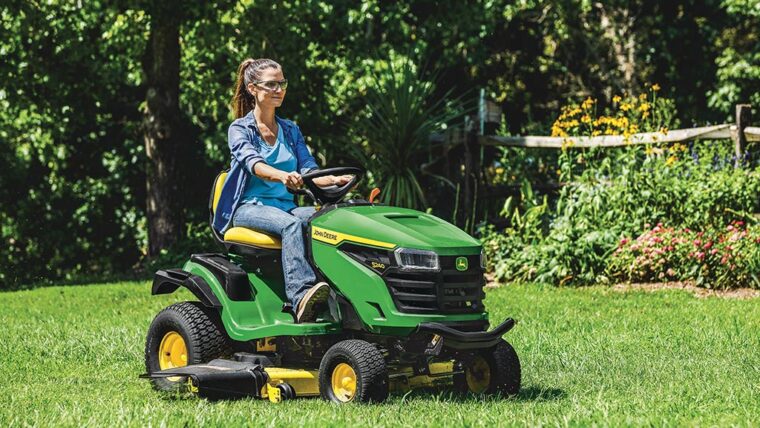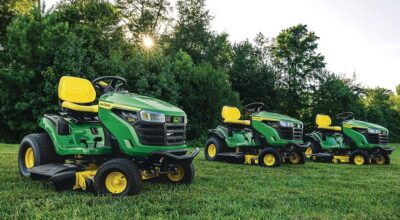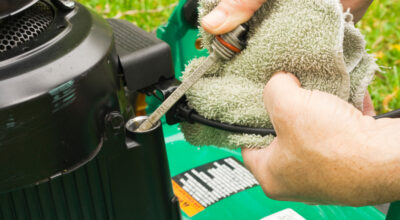When spring rolls around, the perfect way to enjoy the warmer weather is by working in your yard. Your lawn is ready to spring up and show off its beauty after being dormant all winter, and all it needs to look its best is a little help from you!

10 Tips for Effective Spring Lawn Care
Preparing your lawn for spring is not as difficult as it might sound, but there is a bit more involved than just taking your John Deere mower for a spin around the yard. The following spring lawn care tips will help you get your lawn in tip-top shape.
1. Rake
The first thing you should do before jumping on the mower is rake. Raking allows you to get a good look at which areas might need a little more attention as you move on to the next steps. It also helps by pulling up any thatch that developed over the winter. Thatch can be a perfect environment for pests, and it can severely inhibit grass growth.
2. Aerate
Heavy foot traffic can cause lawns and soil to become compacted, which can lead to unwanted moss. To address this issue, consider using a lawn aerator to allow water and air to penetrate the soil and reach the roots of the grass. By getting ahead, you can ensure your grass grows full and strong without any obstructions.
3. Test for Soil Acidity
Soil acidity can go awry during harsh winter months. Since grass does not grow well in soil that is high in acidity, you should take some time and check your soil’s levels. You can find acidity tests at most major home improvement stores. If you find that your soil has a high acidity level, you can balance high acidity levels by applying a thin layer of lime to your lawn.
4. Fertilize
The type of grass you have will determine which type and amount of fertilizer you should use, but it’s a very important step in your lawn’s care and growth. If you have a grass suited for cool weather, it probably didn’t use too much of last year’s fertilizer through its dormant months. That said, warm weather grasses will draw a lot of nutrients out of the soil through the winter. Therefore, they will need an ampler application of fertilizer.
5. Overseed
As noted above, heavy foot traffic can damage a lawn in more ways than one. In addition to causing the soil to become compacted, it can also create worn patches that appear bare and discolored. By sowing seed over existing grass, also known as overseeding, you can fill in these bare patches while also ensuring the rest of your lawn looks as luscious as possible. While fall is typically the best time to take on this task, lawns in dire need of a little TLC can be overseeded in spring.
6. Apply Herbicides
Spring is the perfect time to apply herbicides. You can attack your weed problem before it has a chance to get bad. There are plenty of organic weed killers that are safe for your developing grass, and you can find them at any home improvement or big-box store.
7. Pull Spring Weeds
While dandelions may look bright and joyful, they are also perennial growers that make their first appearance in spring and are incredibly stubborn. Get rid of these weeds by snapping off their flower stem before they produce any seeds. Or better yet, get to the “root” of the cause and dig them out from their roots. Other spring weeds you should look out for include white clover, chickweed, wild violets, and more.
8. Water
Depending on where you live, your lawn may need more water than others. If you live near the mountains or desert areas, water your lawn continuously as if it were still winter. While doing so, be sure to increase irrigation frequency as temperatures increase. In the Midwest and Pacific Northwest areas, spring rains provide a great deal of nourishment and moisture to your lawn. In these regions, it’s important to try and avoid the temptation to overwater your lawn as a means to brighten the color. Lawns will green up naturally so only irrigate if rains become scarce and the grass begins to look dehydrated.
9. Manage Pests and Winter-Related Damage
If you have a problem with pests or molds, spring is a great time to start solving this problem. You also want to make sure you take the time to treat your yard for any damage that occurred during the winter months.
10. Mow Consistently
One of the best lawn care tips for spring is consistent mowing. Mowing your lawn at the right height can help prevent weeds from growing. Although we know you want to use your John Deere as often as you can, cutting grass too short can allow sunlight to directly hit the soil, which can zap away the nutrients. Each type of grass needs to maintain a certain height to look its best, but that doesn’t mean you can’t have fun with your mowing. Take a look at our lawn mowing patterns post for some great ideas and tips!
If you have any questions about John Deere lawn care equipment, you can contact your local John Deere dealer.
If you enjoyed this post or want to read others, feel free to connect with us on Facebook, Pinterest, Twitter, or Instagram!



